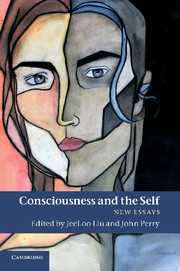Book contents
- Frontmatter
- Contents
- Acknowledgments
- Contributors
- Introduction
- Chapter 1 Awareness and identification of self
- Chapter 2 Self-representationalism and the explanatory gap
- Chapter 3 Thinking about the self
- Chapter 4 Ordinary self-consciousness
- Chapter 5 Waiting for the self
- Chapter 6 I think I think, therefore I am – I think
- Chapter 7 Knowing what I want
- Chapter 8 Self-ignorance
- Chapter 9 Personhood and consciousness
- Chapter 10 My non-narrative, non-forensic Dasein
- References
- Index
Chapter 10 - My non-narrative, non-forensic Dasein
the first and second self
Published online by Cambridge University Press: 05 December 2011
- Frontmatter
- Contents
- Acknowledgments
- Contributors
- Introduction
- Chapter 1 Awareness and identification of self
- Chapter 2 Self-representationalism and the explanatory gap
- Chapter 3 Thinking about the self
- Chapter 4 Ordinary self-consciousness
- Chapter 5 Waiting for the self
- Chapter 6 I think I think, therefore I am – I think
- Chapter 7 Knowing what I want
- Chapter 8 Self-ignorance
- Chapter 9 Personhood and consciousness
- Chapter 10 My non-narrative, non-forensic Dasein
- References
- Index
Summary
Forensic, narrative persons and real everyday persons
In (a widely under-discussed paper) “Sexual identities and narratives of self” (2003), Jill Einstein and I proposed that John Locke’s conception of persons, PersonLocke, despite its merit as an account of forensic persons, is woefully inadequate as an account of the normal everyday sense of who one is, how one feels, the weather within, personality, and so on, which we argued is better captured by a conception articulated by William James, PersonJames. Our unremarkable conclusion was that the forensic conception, “Locke’s resolute cognitive-linguistic view,” needed to be supplemented by “James’s feeling-of-and-for-the body view.” Here I develop our argument further, and in a more provocative direction, arguing that PersonJames is basic and PersonLocke is, at best, a special case. PersonJames is the first self. PersonLocke is the – possibly only “a” – second self. Once this much is established, I further argue that in privileging PersonLocke we open ourselves, even make more likely, a class of projective mistakes in self-understanding. These include first, overrating the constitutive role of autobiographical memories of happenings and doings, and underestimating the constitutive roles of the much larger class of that-which-is-experienced but not remembered; second, projecting normative expectations of self-sameness backwards and forwards over our lives, sometimes in the face of evidence that we do not have (or in the case of the future, evidence we cannot have) that we are, in fact, the same self or person.
Start by granting for the sake of argument that one of the concepts expressed by the polysemous words PERSON or SELF, or, what is different, by one of the homonyms pronounced as PERSON or SELF, can be analyzed usefully in terms of relations of a certain kind of psychological connectedness and continuity, specifically, diachronic memory for things I did or that happened to me. This would be the familiar concept of a forensic person championed by Locke as best suited to account for the identity of humans who are legal and moral agents and accountable as such. The key words in the schema are “a certain kind” of psychological connectedness and continuity. The schema gives permission to analyze personhood in terms of a subset of the experiences that persons have and a subset of the connections among them, specifically, autobiographical memories. A forensic person is a person who consciously remembers and can report what he or she has done, who distinguishes between things he or she did and things that happened to him or her, and who can do so for others. Call such persons, PersonLocke. Forensic persons are called upon to be narrative persons, to self-represent narratively, and to be represented by others as doers of deeds with certain characteristic behavioral dispositions. The two go together like horse and carriage, so I will speak sometimes of one or the other, the forensic or the narrative, but assume the linkage throughout – forensic-narrative persons.
Keywords
- Type
- Chapter
- Information
- Consciousness and the SelfNew Essays, pp. 214 - 240Publisher: Cambridge University PressPrint publication year: 2011

